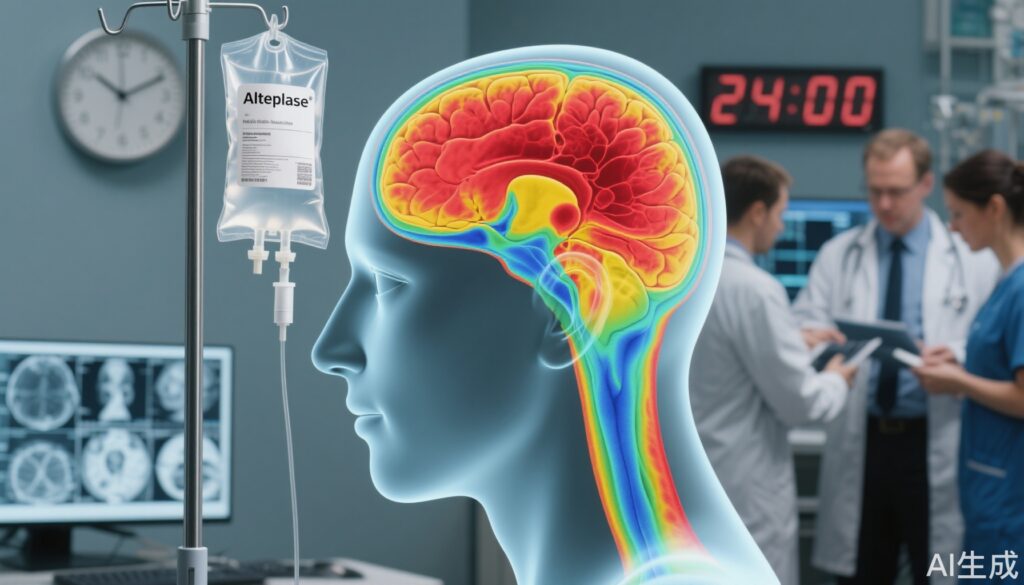Highlights
The HOPE randomized clinical trial (JAMA, 7 Aug 2025) evaluated intravenous alteplase for acute ischemic stroke occurring 4.5–24 hours after symptom onset in patients with CT‑perfusion evidence of salvageable brain tissue and no planned endovascular thrombectomy. Primary outcome (90‑day mRS 0–1) favored alteplase (40.3% vs 26.3%; adjusted RR 1.52, 95% CI 1.14–2.02; p=0.004). Symptomatic intracranial hemorrhage (sICH) was higher with alteplase (3.8% vs 0.5%), but 90‑day mortality was identical (10.8% vs 10.8%).
Study background and disease burden
Acute ischemic stroke accounts for roughly 80% of all strokes. Rapid reperfusion remains the cornerstone for preserving ischemic penumbra and improving functional outcome. Intravenous thrombolysis with alteplase established a standard treatment window of up to 4.5 hours after symptom onset, while mechanical thrombectomy (MT) has proven benefit in selected patients up to 24 hours using perfusion or mismatch imaging (DAWN, DEFUSE 3). However, many patients arrive beyond 4.5 hours and many hospitals—especially non‑comprehensive stroke centers—cannot provide thrombectomy. Extending safe and effective pharmacologic reperfusion to a later, image‑selected window could materially increase the number of patients who achieve meaningful recovery.
Study design
HOPE was a multicenter randomized controlled trial conducted in 26 stroke centers in China, enrolling 372 adult patients with acute ischemic stroke who met the following key criteria: pre‑stroke modified Rankin Scale (mRS) 1.2), and no planned endovascular thrombectomy. Patients were randomized 1:1 to:
– Alteplase group (n=186): intravenous alteplase 0.9 mg/kg (maximum 90 mg) according to standard dosing; after 24 hours, standard post‑stroke care including antiplatelet therapy.
– Standard treatment group (n=186): standard antiplatelet and supportive care without thrombolysis.
The pre‑specified primary efficacy outcome was functional independence at 90 days (mRS 0–1). Secondary outcomes included shift in overall mRS distribution, median mRS, and other functional endpoints. Safety outcomes included symptomatic intracranial hemorrhage (sICH) and 90‑day mortality. The trial allowed use of different CT perfusion post‑processing software, and approximately 36.6% of enrolled patients had distal (non‑large vessel) occlusions.
Key findings
Primary efficacy outcome
– Functional independence (mRS 0–1) at day 90: 40.3% in the alteplase group (75/186) versus 26.3% in the standard treatment group (49/186).
– Absolute difference: 13.98% (95% CI 4.50%–23.45%).
– Adjusted effect: risk ratio (RR) 1.52 (95% CI 1.14–2.02), p=0.004 after adjustment for age, baseline NIHSS, and onset‑to‑randomization time.
Secondary and global outcomes
– Overall distribution of mRS favored alteplase: median mRS 2 vs 3 (alteplase vs standard), indicating a shift toward better functional outcomes across the scale.
– Secondary endpoints (e.g., mRS 0–2) were directionally consistent with primary results (full table in the published paper).
Safety
– Symptomatic intracranial hemorrhage: 3.8% in the alteplase arm vs 0.5% in the standard arm. After adjustment, RR for sICH was 7.34 (p=0.01).
– 90‑day mortality: identical in both groups (10.8% vs 10.8%; adjusted RR 0.91, p=0.76).
Interpretation of effect sizes
– The absolute increase in 90‑day functional independence (~14%) is clinically meaningful and comparable to other acute stroke interventions when applied to appropriately selected patients.
– The increased sICH rate is a real safety trade‑off; however, the lack of excess mortality suggests that many sICH events were non‑fatal or that functional benefits offset mortality risk at the population level.
Subgroup and generalizability notes
– HOPE did not restrict enrollment to patients with large vessel occlusion (LVO); distal occlusions composed 36.6% of the cohort. This broadens potential applicability relative to trials that focused strictly on LVOs.
– Allowing multiple CT perfusion software packages improves external validity across systems that use different post‑processing tools.
– The trial excluded patients with a plan for mechanical thrombectomy; results therefore should not be extrapolated to patients who are candidates for immediate endovascular therapy.
Expert commentary and contextualization
How HOPE fits with prior evidence
– Prior trials demonstrated that imaging‑guided selection can extend reperfusion therapies beyond early time windows: DAWN and DEFUSE 3 established efficacy of thrombectomy to 24 hours in selected patients using mismatch/perfusion paradigms, and WAKE‑UP demonstrated MRI‑guided thrombolysis for unknown‑onset stroke. HOPE applies a similar principle to systemic alteplase in patients not planned for thrombectomy.
Clinical implications
– For patients presenting 4.5–24 hours after symptom onset who have CT perfusion evidence of a small core and substantial penumbra, intravenous alteplase may offer a statistically and clinically significant improvement in functional independence.
– The trial addresses an important practical gap: many centers and regions cannot perform thrombectomy for logistics or resources; HOPE suggests that, with perfusion imaging, more patients might benefit from pharmacologic reperfusion even after the traditional 4.5‑hour window.
Safety considerations
– The elevated sICH risk requires careful patient selection, informed consent, and meticulous monitoring. Clinicians should discuss the absolute risks and expected benefits with patients or surrogates.
Limitations and uncertainties
– The trial population was enrolled entirely in China; although multicenter and pragmatic in permitting various perfusion software, geographic and ethnic factors could influence generalizability.
– The summary did not specify blinding; if the trial was open‑label, outcome assessment blinding would be important to reduce bias for functionally scored endpoints.
– Patients scheduled for thrombectomy were excluded; therefore HOPE does not inform the question of combined or sequential therapy for LVO patients who might be transferred for EVT.
– Longer‑term outcomes beyond 90 days, quality‑of‑life measures, and cost‑effectiveness were not reported in the primary paper and will be important to evaluate.
Research next steps
– Independent replication in diverse populations and health‑system contexts.
– Trials that examine alteplase in imaging‑selected patients who are remote from thrombectomy centers but may be candidates for later transfer, or trials explicitly comparing alteplase versus urgent transfer for thrombectomy in intermediate settings.
– Optimization of imaging thresholds (core and mismatch criteria) and exploration of biomarkers to refine risk of sICH.
Practical guidance for clinicians
– Consider CT perfusion for patients presenting beyond 4.5 hours when the last‑known‑well time is within 24 hours and the patient has a favorable pre‑stroke status (mRS 1.2 and thrombectomy is not planned or feasible, discuss the HOPE data with the patient/surrogate: potential for improved independence (absolute benefit ~14%) balanced against increased sICH risk.
– Maintain rigorous post‑thrombolysis monitoring and stroke unit care. Enroll patients in registries where possible to contribute to post‑marketing/real‑world evidence.
Conclusion
The HOPE trial provides high‑quality randomized evidence that intravenous alteplase, when applied to CT‑perfusion selected patients without a plan for thrombectomy, improves 90‑day functional independence when administered 4.5–24 hours after stroke onset. The benefit comes with an increased risk of symptomatic intracranial hemorrhage but without increased 90‑day mortality in the trial. These results support an imaging‑guided, physiology‑based expansion of thrombolysis eligibility in settings where thrombectomy is not planned, while highlighting the need for careful patient selection, shared decision‑making, and further studies to confirm generalizability and refine selection criteria.
References
Zhou Y, He Y, Campbell BCV, et al. Alteplase for Acute Ischemic Stroke at 4.5 to 24 Hours: The HOPE Randomized Clinical Trial. JAMA. Published online August 07, 2025. doi:10.1001/jama.2025.12063
Nogueira RG, Jadhav AP, Haussen DC, et al. Thrombectomy 6 to 24 Hours after Stroke with a Mismatch between Deficit and Infarct. N Engl J Med. 2018;378:11–21. (DAWN trial)
Albers GW, Marks MP, Kemp S, et al. Thrombectomy for Stroke at 6 to 16 Hours with Selection by Perfusion Imaging. N Engl J Med. 2018;378:708–718. (DEFUSE 3 trial)
Thomalla G, Simonsen CZ, Boutitie F, et al. MRI‑Guided Thrombolysis for Stroke with Unknown Time of Onset. N Engl J Med. 2018;379:611–622. (WAKE‑UP trial)
Powers WJ, Rabinstein AA, Ackerson T, et al. 2018 Guidelines for the Early Management of Patients With Acute Ischemic Stroke: A Guideline for Healthcare Professionals From the American Heart Association/American Stroke Association. Stroke. 2018;49:e46–e99.
ClinicalTrials.gov. 24 Hours Treatment with Alteplase in Patients with Ischemic Stroke. NCT04879615. Accessed July 13, 2025.


